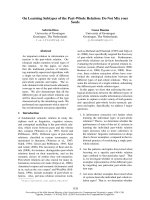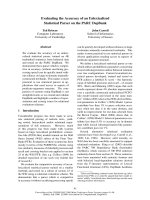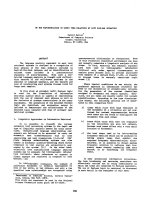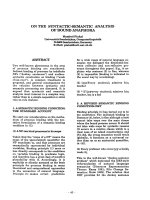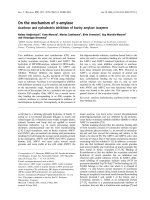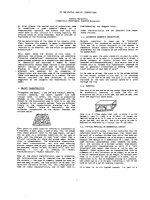Báo cáo khoa học: "On the Equivalence of Weighted Finite-state Transducers" potx
Bạn đang xem bản rút gọn của tài liệu. Xem và tải ngay bản đầy đủ của tài liệu tại đây (76.22 KB, 4 trang )
On the Equivalence of Weighted Finite-state Transducers
Julien Quint
National Institute of Informatics
Hitotsubashi 2-1-2
Chiyoda-ku
Tokyo 101-8430
Japan
Abstract
Although they can be topologically different, two
distinct transducers may actually recognize the
same rational relation. Being able to test the equiv-
alence of transducers allows to implement such op-
erations as incremental minimization and iterative
composition. This paper presents an algorithm for
testing the equivalence of deterministic weighted
finite-state transducers, and outlines an implemen-
tation of its applications in a prototype weighted
finite-state calculus tool.
Introduction
The addition of weights in finite-state devices
(where transitions, initial states and final states are
weighted) introduced the need to reevaluate many
of the techniques and algorithms used in classical
finite-state calculus. Interesting consequences are,
for instance, that not all non-deterministic weighted
automata can be made deterministic (Buchsbaum
et al., 2000); or that epsilon transitions may offset
the weights in the result of the composition of two
transducers (Pereira and Riley, 1997).
A fundamental operation on finite-state transduc-
ers in equivalence testing, which leads to applica-
tions such as incremental minimization and itera-
tive composition. Here, we present an algorithm
for equivalence testing in the weighted case, and
describe its application to these applications. We
also describe a prototype implementation, which is
demonstrated.
1 Definitions
We define a weighted finite-state automata (WFST)
T over a set of weights K by an 8-tuple
(Σ, Ω, Q, I, F, E, λ, ρ) where Σ and Ω are two fi-
nite sets of symbols (alphabets), Q is a finite set of
states, I ⊆ Q is the set of initial states, F ⊆ Q is the
set of final states, E ⊆ Q×Σ∪{ε} ×Ω∪{ε}×K×Q
is the set of transitions, and λ : I → K and
ρ : F → K are the initial and final weight func-
tions.
A transition e ∈ E has a label l(e) ∈ Σ∪{}×Ω∪
{}, a weight w(e) ∈ K and a destination δ(e) ∈ Q.
The set of weights is a semi-ring, that is a system
(K, ⊕, ⊗,
¯
0,
¯
1) where
¯
0 is the identity element for
⊕,
¯
1 is the identity element for ⊗, and ⊕ is com-
mutative (Berstel and Reteunauer, 1988). The cost
of a path in a WFST is the product (⊗) of the initial
weight of the initial state, the weight of all the tran-
sitions, and the final weight of the final state. When
several paths in the WFST match the same relation,
the total cost is the sum (⊕) of the costs of all the
paths.
In NLP, the tropical semi-ring (R
+
∪
{∞}, min, +, ∞, 0) is very often used: weights
are added along a path, and if several paths match
the same relation, the total cost is the cost of the
path with minimal cost. The following discussion
will apply to any semi-ring, with examples using
the tropical semi-ring.
2 The Equivalence Testing Algorithm
Several algorithms testing the equivalence of two
states are presented in (Watson and Daciuk, 2003),
from which we will derive ours. Two states are
equivalent if and only if their respective right lan-
guage are equivalent. The right language of a state
is the set of words originating from this state. Two
deterministic finite-state automata are equivalent if
and only if they recognize the same language, that
is, if their initial states have the same right language.
Hence, it is possible to test the equivalence of two
automata by applying the equivalence algorithm on
their initial states.
In order to test the equivalence of two WFSTs, we
need to extend the state equivalence test algorithm
in two ways: first, it must apply to transducers, and
second, it must take weights into account. Handling
transducers is easily achieved as the labels of transi-
tions defined above are equivalent to symbols in an
alphabet (i.e. we consider the underlying automaton
of the transducer).
Taking weights into account means that for
two WFSTs to be equivalent, they must recog-
nize the same relation (or their underlying au-
tomata must recognize the same language), with the
same weights. However, as illustrated by figure 1,
two WFSTs can be equivalent but have a different
weight distribution. States 1 and 5 have the same
right language, but words have different costs (for
example, abad has a cost of 6 in the top automaton,
and 5 in the bottom one). We notice however that
the difference of weights between words is constant,
so states 1 and 5 are really equivalent modulo a cost
of 1.
0 1
c/1
2
a/1
b/2
3/0
d/2
4 5
c/2
6
a/2
b/1
7/0
d/0
Figure 1: Two equivalent weighted finite-state
transducers (using the tropical semi-ring).
Figure 2 shows the weighted equivalence algo-
rithm. Given two states p and q, it returns a true
value if they are equivalent, and a false value other-
wise. Remainder weights are also passed as param-
eters w
p
and w
q
. The last parameter is an associative
array S that we use to keep track of states that were
already visited.
The algorithm works as follows: given two states,
compare their signature. The signature of a state is
a string encoding its class (final or not) and the list
of labels on outgoing transition. In the case of de-
terministic transducers, if the signature for the two
states do not match, then they cannot have the same
right language and therefore cannot be equivalent.
Otherwise, if the two states are final, then their
weights (taking into account the remainder weights)
must be the same (lines 6–7). Then, all their outgo-
ing transitions have to be checked: the states will
be equivalent if matching transitions lead to equiva-
lent states (lines 8–12). The destination states are
recursively checked. The REMAINDER function
computes the remainder weights for the destination
states. Given two weights x and y, it returns {
¯
1,
x ⊗ y
−1
} if x < y, and {x
−1
⊗ y,
¯
1} otherwise.
If there is a cycle, then we will see the same pair
of states twice. The weight of the cycle must be the
same in both transducers, so the remainder weights
must be unchanged. This is tested in lines 2–4.
The algorithm applies to deterministic WFSTs,
which can have only one initial state. To test the
equivalence of two WFSTs, we call EQUIV on the
respective initial states of the the WFSTs with their
initial weights as the remainder weights, and S is
initially empty.
3 Incremental minimization
An application of this equivalence algorithm is the
incremental minimization algorithm of (Watson and
Daciuk, 2003). For every deterministic WFST T
there exists at least one equivalent WFST M such
that no other equivalent WFST has fewer states (i.e.
|Q
M
| is minimal). In the unweighted case, this
means that there cannot be two distinct states that
are equivalent in the minimized transducer.
It follows that a way to build this transducer M
is to compare every pair of distinct states in Q
A
and
merge pairs of equivalent states until there are no
two equivalent states in the transducer. An advan-
tage of this method is that at any time of the appli-
cation of the algorithm, the transducer is in a consis-
tent state; if the process has to finish under a certain
time limit, it can simply be stopped (the number of
states will have decreased, even though the mini-
mality of the result cannot be guaranteed then).
In the weighted case, merging two equivalent
states is not as easy because edges with the same la-
bel may have a different weight. In figure 3, we see
that states 1 and 2 are equivalent and can be merged,
but outgoing transitions have different weights. The
remainder weights have to be pushed to the follow-
ing states, which can then be merged if they are
equivalent modulo the remainder weights. This ap-
plies to states 3 and 4 here.
0
1
a/1
2
b/1
3
a/2
4
a/1
b/0
5/0
c/1
b/0
6/0
c/2
0 1
a/1
b/1
2
a/2
b/0
3/0
c/1
Figure 3: Non-minimal transducer and its mini-
mized equivalent.
4 Generic Composition with Filter
As shown previously (Pereira and Riley, 1997), a
special algorithm is needed for the composition of
WFSTs. A filter is introduced, whose role is to han-
dle epsilon transitions on the lower side of the top
transducer and the upper side of the lower trans-
ducer (it is also useful in the unweighted case). In
our implementation described in section 5 we have
generalized the use of this epsilon-free composition
operation to handle two operations that are defined
EQUIV(p, w
p
, q, w
q
, S)
1 equiv ← FALSE
2 if S[{p, q}] = NIL
3 then {w
p
, w
q
} ← S[{p, q}]
4 equiv ← w
p
= w
p
∧ w
q = w
q
5 else if SIGNATURE(p) = SIGNATURE(q)
6 then if FINAL(p)
7 then equiv ← w
p
⊗ ρ(p) = w
q
⊗ ρ(q)
8 S[{p, q}] ← {w
p
, w
q
}
9 for e
p
∈ E(p), e
q
∈ E(q), l(e
p
) = l(e
q
)
10 do {w
p
, w
q
} ← REMAINDER(w
p
⊗ w(e
p
), w
q
⊗ w(e
q
))
11 equiv ← equiv ∧EQUIV(δ(e
p
), w
p
, δ(e
q
), w
q
, S)
12 DELETE(S[{p, q}])
13 return equiv
Figure 2: The equivalence algorithm
on automata only, that is intersection and cross-
product. Intersection is a simple variant of the com-
position of the identity transducers corresponding to
the operand automata.
Cross-product uses the exact same algorithm but
a different filter, shown in figure 4. The prepro-
cessing stage for both operand automata consists of
adding a transition with a special symbol x at every
final state, going to itself, and with a weight of
¯
1.
This will allow to match words of different lengths,
as when one of the automata is “exhausted,” the x
symbol will be added as long as the other automa-
ton is not. After the composition, the x symbol is
replaced everywhere by .
0/0
?:?/0
1/0
?:x/0
2/0
x:?/0
?:x/0
x:?/0
Figure 4: Cross-product filter. The symbol “?”
matches any symbol; “x” is a special espilon-
symbol introduced in the final states of the operand
automata at preprocessing.
The equivalence algorithm that is the subject of
this paper is used in conjunction with composition
of WFSTs in order to provide an iterative com-
position operator. Given two transducers A and
B, it composes A with B, then composes the re-
sult with B again, and again, until a fixed-point
is reached. This can be determined by testing the
equivalence of the last two iterations. Roche and
Schabes (1994) have shown that in the unweighted
case this allows to parse context-free grammars with
finite-state transducers; in our case, a cost can be
added to the parse.
5 A Prototype Implementation
The algorithms described above have all been im-
plemented in a prototype weighted finite-state tool,
called wfst, inspired from the Xerox tool xfst
(Beesley and Karttunen, 2003) and the FSM library
from AT&T (Mohri et al., 1997). From the former, it
borrows a similar command-line interface and reg-
ular expression syntax, and from the latter, the ad-
dition of weights. The system will be demonstrated
and should be available for download soon.
The operations described above are all avail-
able in wfst, in addition to classical opera-
tions like union, intersection (only defined on
automata), concatenation, etc. The regular ex-
pression syntax is inspired from xfst and Perl
(the implementation language). For instance, the
automaton of figure 3 was compiled from the
regular expression (a/1 a/2 b/0* c/1) |
(b/2 a/1 b/0* c/2) and the iterative compo-
sition of two previously defined WFSTs A and B is
written $A %+ $B (we chose % as the composition
operator, and + refers to the Kleene plus operator).
Conclusion
We demonstrate a simple and powerful experimen-
tal weighted finite state calculus tool and have de-
scribed an algorithm at the core of its operation for
the equivalence of weighted transducers. There are
two major limitations to the weighted equivalence
algorithm. The first one is that it works only on de-
terministic WFSTs; however, not all WFSTs can be
determinized. An algorithm with backtracking may
be a solution to this problem, but its running time
would increase, and it remains to be seen if such
an algorithm could apply to undeterminizable trans-
ducers.
The other limitation is that two transducers rec-
ognizing the same rational relation may have non-
equivalent underlying automata, and some labels
will not match (e.g. {a, }{b, c} vs. {a, c}{b, }).
A possible solution to this problem is to consider
the shortest string on both sides and have “remain-
der strings” like we have remainder weights in the
weighted case. If successful, this technique could
yield interesting results in determinization as well.
References
Kenneth R. Beesley and Lauri Karttunen. 2003. Fi-
nite State Morphology. CSLI Publications, Stan-
ford, California.
Jean Berstel and Christophe Reteunauer. 1988. Ra-
tional Series and their Languages. Springer Ver-
lag, Berlin, Germany.
Adam L. Buchsbaum, Raffaele Giancarlo, and Jef-
fery R. Westbrook. 2000. On the determiniza-
tion of weighted finite automata. SIAM Journal
on Computing, 30(5):1502–1531.
Mehryar Mohri, Fernando C. N. Pereira, and
Michael Riley. 1997. A rational design for a
weighted finite-state transducer library. In Work-
shop on Implementing Automata, pages 144–158,
London, Ontario.
Fernando C. N. Pereira and Michael Riley. 1997.
Speech recognition by composition of weighted
finite state automata. In Emmanuel Roche and
Yves Schabes, editors, Finite-State Language
Processing, pages 431–453. MIT Press, Cam-
bridge, Massachusetts.
Emmanuel Roche and Yves Schabes. 1994. Two
parsing algorithms by means of finite state trans-
ducers. In Proceedings of COLING’94, pages
431–435, Ky¯ot¯o, Japan.
Bruce W. Watson and Jan Daciuk. 2003. An effi-
cient incremental DFA minimization algorithm.
Natural Language Engineering, 9(1):49–64.

